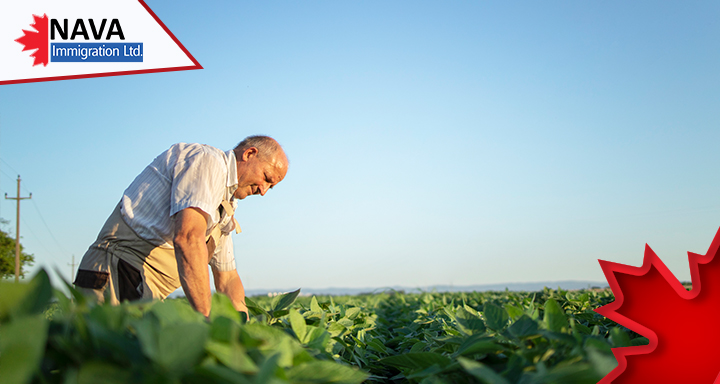Vacancies in Agriculture & Agri-Food Labor Force
Agriculture and Agri-Food is among the five occupation-based categories prioritized by the Immigration, Refugees and Citizenship Canada (IRCC) for Express Entry Category based selections in 2023.
The department of IRCC announced the category-based selection draws in May this year under Express Entry in an effort to support employment sectors with some of the most severe labor market deficits.
These draws are meant to attract potential candidates with work experience in any of the selected categories who are interested in immigrating to Canada. The first category-based draw was held on June 28. The government has chosen these categories when it recognizes the need for workers in these sectors of the country to expand and succeed.
Express Entry categories for 2023 consist of the following categories: healthcare, science, technology, engineering, and mathematics (STEM); transport; trades; and agriculture/agri-food.
These category-based draws differ from the standard Express Entry draws as the standard Express Entry draw uses the Comprehensive Ranking System (CRS) scores, whereas the new category-based draw focuses on candidates’ work experience.
Vacancies in Agriculture & Agri-Food Labor Force: Why Canada Chose this Category?
According to the Canadian Agricultural Human Resource Council (CAHRC), the Agriculture & Agri-Food Labor Force category is expected to have over 123,000 employment opportunities compared to the local labor force by 2029.
Due to the fact that Agriculture and agri-food are extremely important to Canada’s sustainability and development, Canada regards it as a category under Express Entry that deserves special attention.
Additionally, CAHRC states that annually, the agriculture and agri-food sectors contribute over $122 billion, which is 6.3% of Canada’s GDP. This contribution to the economy is expected to grow as the demand for food and agricultural products is expanding around the globe.
This emphasizes the importance of agriculture and agri-food industries to Canada as a whole, proving why IRCC picked this sector for its own category-based Express Entry selections in 2023.
Canada’s demand for Agriculture & Agri-Food workers
A report on agriculture industry workers was released on April 29 by the Canadian Broadcasting Corporation (CBC). According to this report, the president of Nova Scotia’s Federation of Agriculture states that by 2029, the province of Nova Scotia might face a shortage of over 2500 farm workers.
This occurred at a time when Government of Canada Job Bank data revealed a drop in employment of over 20,000 industry workers in a Canadian province over the previous decade. Particularly, this data shows that employment in Alberta, in the Agriculture sector, dropped by 28,300 Jobs from 2013 to 2022, which is approximately a drop of 44%.
In addition, industry employment in British Columbia has dropped by approximately 10% over the past decade.
Given that certain provinces require more people in the Agriculture and agri-food sectors compared to others, this data reflects the major workforce shortages in this sector across Canada.
In addition to this, CBC also released a report prior to two weeks report, which stated that within a decade, approximately 40% of Canadian farmers are expected to retire.
Also, according to the same report, 66% of farmers don’t have a succession plan, and researchers believe that the agriculture industry to lose 24,000 farm, nursery, and greenhouse workers.
This report concludes that, as per these factors, Canada has to admit 30,000 farm-skilled workers to address the labor gaps in this sector.
Overall, as per these reports, Canada will require many thousands of agriculture and agri-food workers in order to address the labor market shortages in this sector over time.
Immigration Opportunities for Future Immigrants to Canada
According to the CAHRC report, Canada’s agriculture industry has become more dependent on internationally skilled workers due to the shortage of local skills to address the labor market needs in this area.
In reality, more than 75% of the vacancies in the Agriculture & agri-food Labor Force in Canada were filled by Canadian immigrants. Also, more than one in six individuals in the Canadian agricultural workforce were international workers, which is approximately 17%.
Given that, in 2017, Canada was still unable to fill over 16,000 jobs, and that the vacancies in the Agriculture & agri-food industry have grown since then, prospective immigrants to Canada interested in agriculture/agri-food work may find a considerable amount of employment opportunities for new immigrants through this targeted occupational category.
Summary of agriculture & agri-food category-based draws.
The first-ever category-based draw for the agriculture & agri-food category was held by the department of IRCC recently.
This year, in August, the Globe and Mail obtained data from IRCC showing that the draws for the agriculture & agri-food category would account for 1 or 2% of the future Invitations to Apply (ITAs) to be issued by the IRCC.
These ITAs would be released under the 2023 Express Entry remainder draws.





